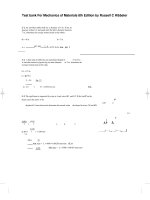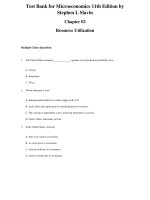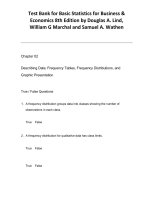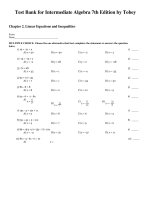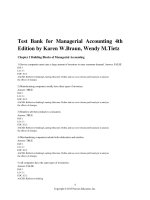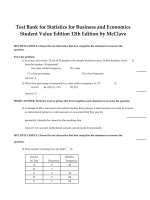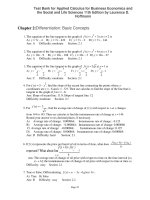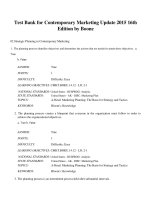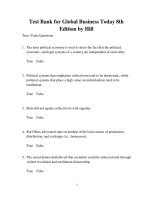Link full download test bank for basic statistics for business and economics 8th edition by lind marchal and wathen
Bạn đang xem bản rút gọn của tài liệu. Xem và tải ngay bản đầy đủ của tài liệu tại đây (1.07 MB, 221 trang )
Test Bank for Basic Statistics for Business &
Economics 8th Edition by Douglas A. Lind,
William G Marchal and Samuel A. Wathen
Chapter 02
Describing Data: Frequency Tables, Frequency Distributions, and
Graphic Presentation
True / False Questions
1. A frequency distribution groups data into classes showing the number of
observations in each class.
True
False
2. A frequency distribution for qualitative data has class limits.
True
False
True
False
3. To summarize the gender of students attending a college, the number of classes
in a frequency distribution depends on the number of students.
4. In frequency distributions, classes are mutually exclusive if each individual,
object, or measurement is included in only one category.
True
False
5. In a bar chart, the x-axis is labeled with the values of a qualitative variable.
True
False
6. In a bar chart, the heights of the bars represent the frequencies in each class.
True
False
7. The midpoint of a class, which is also called a class mark, is halfway between the
lower and upper limits.
True
False
Test Bank for Basic Statistics for Business &
Economics 8th Edition by Douglas A. Lind,
William G Marchal and Samuel A. Wathen
True
False
8. A class interval, or class width, can be determined by subtracting the lower limit
of a class from the lower limit of the next higher class.
9. To convert a frequency distribution to a relative frequency distribution, divide
each class frequency by the sum of the class frequencies.
True
False
10. To convert a frequency distribution to a relative frequency distribution, divide
each class frequency by the number of classes.
True
False
11. A pie chart is similar to a relative frequency distribution.
True
False
True
False
12. A pie chart shows the relative frequency in each class.
True
False
13. To construct a pie chart, relative class frequencies are used to graph the "slices"
of the pie.
True
False
14. A cumulative frequency distribution is used when we want to determine how many
observations lie above or below certain values.
True
False
15. A frequency polygon is a very useful graphic technique when comparing two or
more distributions.
True
False
Multiple Choice Questions
16. Monthly commissions of first-year insurance brokers are $1,270, $1,310, $1,680,
$1,380, $1,410, $1,570, $1,180 and $1,420. These figures are referred to as a(n)
__________.
A. Histogram
B. Raw data
C. Frequency distribution
D. Frequency polygon
17. A small sample of computer operators shows monthly incomes of $1,950, $1,775,
$2,060, $1,840, $1,795, $1,890, $1,925, and $1,810. What are these ungrouped
numbers called?
A. Histogram
B. Class limits
C. Class freque ncies
D. Raw data
18. When data is collected using a quantitative, ratio variable, what is true about a
frequency distribution that summarizes the data?
A. Upper and lower class limits must be calculated.
B. A pie chart can be used to summarize the data.
C. Number of classes is equal to the number of variable's values.
D. The "5 to the k rule" can be applied.
19. When data is collected using a qualitative, nominal variable, what is true about a
frequency distribution that summarizes the data?
A. The upper and lower class limits must be calculated.
B. A pie chart can be used to summarize the data.
C. The number of classes is equal to the number of variable's values plus 2.
D. The "5 to the k rule" can be applied.
20. When data is collected using a qualitative, nominal variable (in other words, male
or female), what is true about a frequency distribution that summarizes the data?
A. The upper and lower class limits must be calculated.
B. Class midpoints can be computed.
C. The number of classes corresponds to the number of a variable's values.
D. The "2 to the k rule" can be applied.
21. A student was interested in the cigarette smoking habits of college students and
collected data from an unbiased random sample of students. The data is
summarized in the following table:
Why is the table NOT a frequency distribution?
A. The number of males does not equal the sum of males that smoke and do not
smoke.
B. The classes are not mutually exclusive.
C. There are too many classes.
D. Class limits cannot be computed.
22. A student was interested in the cigarette smoking habits of college students and
collected data from an unbiased random sample of students. The data is
summarized in the following table:
What type of chart best represents the frequency table?
A. Bar chart
B. Box plot
C. Scatter plot
D. Frequency polygon
23. A student was interested in the cigarette smoking habits of college students and
collected data from an unbiased random sample of students. The data is
summarized in the following table:
What type of chart best represents relative class frequencies?
A. Box plot
B. Pie chart
C. Scatter plot
D. Frequency polygon
24. When a class interval is expressed as 100 up to 200,
_________________________.
A. Observations with values of 100 are excluded from the class
B. Observations with values of 200 are included in the class
C. Observations with values of 200 are exclud
ed from the class
D. The class interval is 99
25. For a relative frequency distribution, relative frequency is computed as
_____________.
A. The class width divided by class interval
B. The class midpoint divided by the class frequency
C. The class frequency divided by the class interval
D. The class frequency divided by the total frequency.
26. The relative frequency for a class represents the ________________.
A. Class width
B. Class midpoint
C. Class interval
D. P ercent of observations in the class
27. A group of 100 students was surveyed about their interest in a new International
Studies program. Interest was measured in terms of high, medium, or low. In the
study, 30 students responded high interest, 40 students responded medium
interest, and 30 students responded low interest. What is the relative frequency of
students with high interest?
A. .30
B. .50
C. .40
D. .030
28. A group of 100 students were surveyed about their interest in a new Economics
major. Interest was measured in terms of high, medium, or low. In the study, 30
students responded high interest, 50 students responded medium interest, and 20
students responded low interest. What is the best way to illustrate the relative
frequency of student interest?
A. Use a cumulative frequency polygon
B. Use a box plot
C. Use a pie chart
D. Use a frequency table
29. The monthly salaries of a sample of 100 employees were rounded to the nearest
$10. They ranged from a low of $1,040 to a high of $1,720. If we want to
condense the data into seven classes, what is the most convenient class
interval?
A. $50
B. $100
C. $150
D. $200
30. A student was studying the political party preferences of a university's student
population. The survey instrument asked students to identify themselves as a
Democrat or a Republican. This question is flawed because:
A. Students generally don't know their political preferences.
B. The categories are generally mutually exclusive.
C. The categories are not exhaustive.
D. Political preference is a continuous variable.
31. A student was studying the political party preferences of a university's student
population. The survey instrument asked students to identify their political
preference, for example, Democrat, Republican, Libertarian, or another party. The
best way to illustrate the frequencies for each political preference is a
__________.
A. Bar chart
B. Box plot
C. Histogram
D. Frequency polygon
32. A student was studying the political party preferences of a university's student
population. The survey instrument asked students to identify their political
preference—for example, Democrat, Republican, Libertarian, or another party.
The best way to illustrate the relative frequency distribution is a __________.
A. Bar chart
B. Pie chart
C. Histogram
D. Frequency polygon
33. What is the following table called?
A. Histogram
B. Frequency polygon
C. Cumulative frequenc
y distribution
D. Frequency distribution
34. For the following distribution of heights, what are the limits for the class with the
greatest frequency?
A. 64 and up to 70
B. 65 and 69
C. 65
and up to 70
D. 69.5
and 74.5
35. In a frequency distribution, the number of observations in a class is called the
class ________.
A. Midpoint
B. Interval
C. Array
D. Frequency
36. Why are unequal class intervals sometimes used in a frequency distribution?
A. To avoid a large number of empty classes
B. For the sake of variety in presenting the data
C. To make the class frequencies smaller
D. To avoid the need for midpoints
37. The number of employees less than the upper limit of each class at Lloyd's Fast
Food Emporium is shown in the following table:
What is it called?
A. A histogram
B. A cumulative frequency table
C. A pie chart
D. A frequency polygon
38. A sample distribution of hourly earnings in Paul's Cookie Factory is:
The limits of the class with the smallest frequency are:
A. $6.00 and $9.00
B. $12.00 and up to $14.00
C. $11.75 and $14.25
D. $12.00 and up to $15.00
39. Refer to the following distribution of commissions:
What is the relative frequency for those salespersons that earn from $1,600 up to
$1,800?
A. .02
B. .024
C. .20
D. .24
